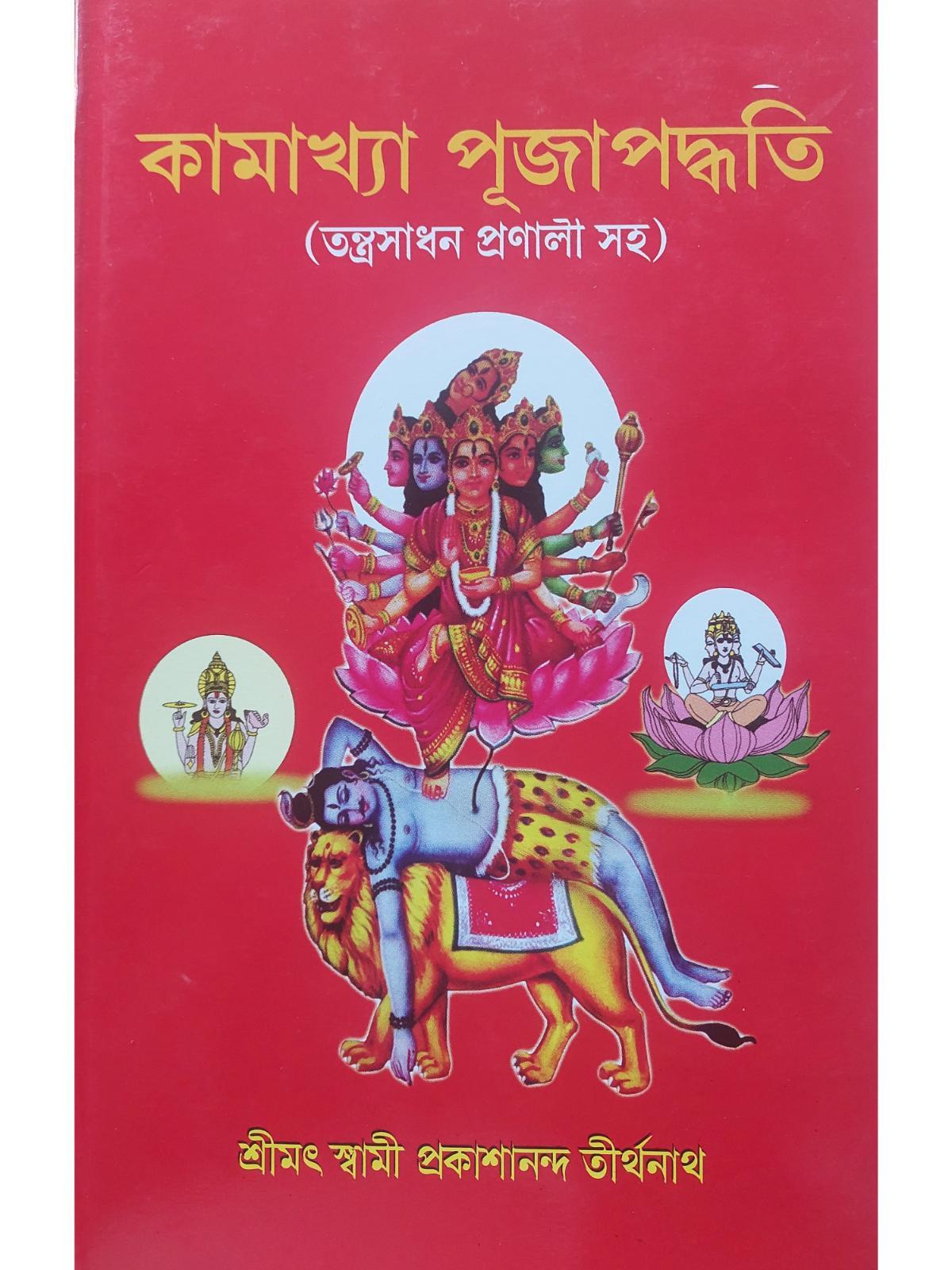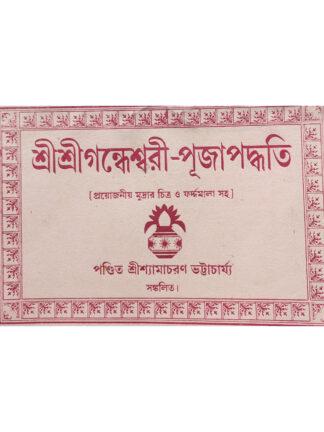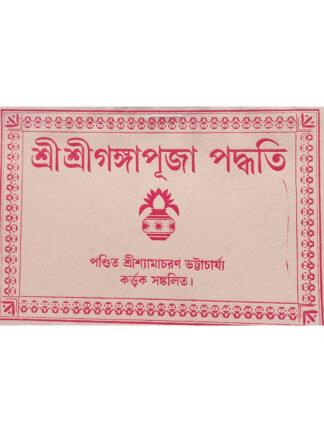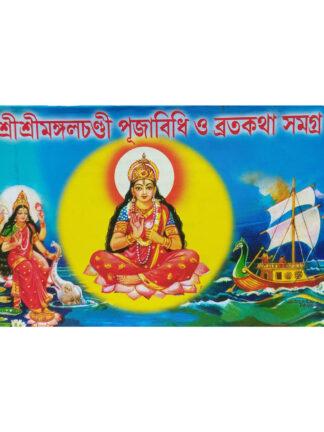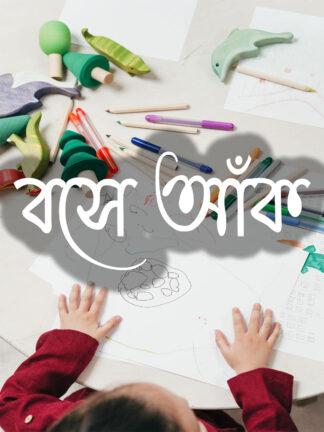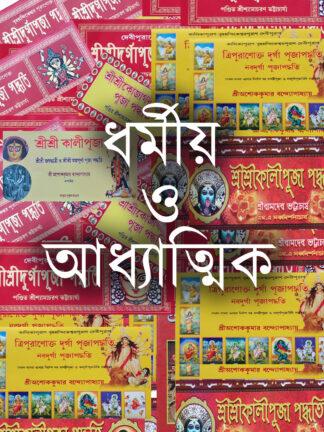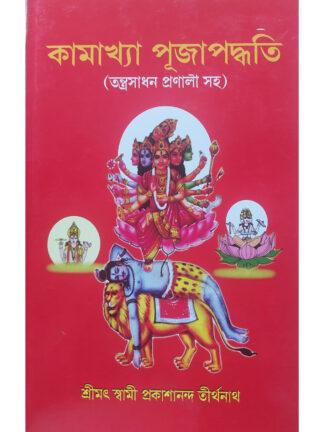Description
Buy Kamakhya Puja Paddhati Book written by Swami Prakashananda Tirthanath and published by Sarada Prakashan. Get a huge number of Book written by Swami Prakashananda Tirthanath from our online book shop.
We have a tremendous collection of Books written by Swami Prakashananda Tirthanath. Sarada Prakashan is a popular name in publication world. Almost all books published by Sarada Prakashan are available in our online store.
Kamakhya Puja Paddhati is one of the bestselling books. If you are searching Kamakhya Puja Paddhati then you are at right place. You can buy Kamakhya Puja Paddhati at an affordable price.
Unveiling the Mysteries: Exploring the Kamakhya Devi Mantra
Welcome, fellow seekers of divine wisdom and spiritual enlightenment! Today, we embark on a captivating journey into the mystical realm of the Kamakhya Temple and its enigmatic deity, Maa Kamakhya. Nestled amidst the lush green landscapes of Assam in Northeast India, this ancient temple holds secrets that have puzzled historians and devotees for centuries.
Prepare to be mesmerized as we delve into the historical background, mythical origins, and intriguing legends surrounding this sacred site. Discover the significance of the Kamakhya Devi Mantra that has captured hearts and minds for generations. And hold your breath as we unravel one of nature’s most awe-inspiring phenomena – when the mighty Brahmaputra River mysteriously turns crimson during certain times of year.
So join us on this extraordinary expedition as we unlock hidden knowledge about Kamakhya Devi Mandir – a place where faith intertwines with mysticism, where prayers are answered with love, and where devotees find solace in their pursuit of enlightenment. Are you ready to immerse yourself in an enchanting world filled with wonder? Then let us begin our quest!
Historical Background of Kamakhya Temple
The Kamakhya Temple, located atop the Nilachal Hill in Guwahati, Assam, is not just a place of worship but an architectural marvel that stands as a testament to India’s rich cultural heritage. Its historical background dates back centuries, with roots deeply intertwined with mythology and ancient traditions.
According to historians, the temple’s existence can be traced back to the 8th century when it was believed to have been built by the Koch dynasty rulers. Over time, it underwent numerous renovations and expansions under various dynasties like the Pala and Ahom kingdoms.
Legend has it that Kamakhya Temple holds sacred significance due to its connection with Goddess Sati – Lord Shiva’s consort. The story goes that after Sati sacrificed herself in her father Daksha’s yagna (sacrificial fire), Lord Shiva carried her charred remains across different regions of India. It is believed that while carrying her uterus or yoni here at Nilachal Hill, Sati manifested as Maa Kamakhya.
The architecture of this ancient shrine showcases a blend of Hindu and indigenous styles. With its distinctive dome-shaped roof called “Shikhara,” intricate carvings depicting gods and goddesses adorning its walls, and mesmerizing sculptures showcasing spiritual motifs – every corner tells a tale from our glorious past.
Kamakhya Temple isn’t just another religious site; it represents power – specifically feminine power or Shakti. The deity worshipped here is revered as one among 51 shakti peethas (sacred abodes) scattered across India. Devotees flock here seeking blessings for fertility, love relationships, prosperity, and spiritual awakening.
Despite being rooted in history and tradition, Kamakhya Temple continues to evolve with changing times. It now attracts pilgrims from all walks of life who are drawn not only by their faith but also by their curiosity about this mystical place and its divine energy.
The Kamakhya Temple stands as a testament to the rich cultural heritage of India. Its origins can be traced back to ancient times, with references dating as far back as the 7th century. Throughout its history, this sacred site has witnessed the rise and fall of empires, weathered invasions, and remained a beacon of spirituality.
Legend has it that during Lord Shiva’s cosmic dance in grief over his wife Sati’s death, her body was dismembered into 51 parts which fell across different parts of the Indian subcontinent. The yoni (female genitalia) fell at Nilachal Hill in Assam, giving birth to the Kamakhya Devi temple.
Over time, various dynasties including those of Guptas and Pala rulers have contributed to its expansion and architectural magnificence. The temple underwent significant restoration under Ahom kings who ruled Assam for six centuries.
The unique feature of this temple is its absence of an idol representing Goddess Kamakhya. Instead, devotees worship a stone symbolizing her yoni or womb-like form called ‘Garbhagriha.’ This unconventional representation symbolizes fertility and feminine energy.
Each year during Ambubachi Mela festival held in June-July, thousands flock from all corners seeking blessings for health and prosperity. It is believed that during these three days, Goddess Kamakhya undergoes her annual menstrual cycle rejuvenating divine powers within herself.
The historical background of the Kamakhya Temple weaves together myths, legends, faiths from diverse cultures resulting in a tapestry that continues to enthrall visitors till today. Beyond just being an architectural marvel or religious center – it represents an eternal connection between humanity and divinity – transcending time itself!
The Kamakhya Temple, also known as the Kamrup-Kamakhya temple, holds a significant place in Hindu mythology and history. Its origins can be traced back to ancient times, with mentions in various scriptures and legends. The temple is dedicated to Goddess Kamakhya, who is revered as the ultimate source of feminine power.
According to popular belief, this sacred site marks the spot where the reproductive organs of Sati (Goddess Parvati) fell after her body was dismembered by Lord Vishnu’s Sudarshan Chakra. This event occurred during Lord Shiva’s Tandava dance of destruction when he carried Sati’s lifeless body across the cosmos.
Over time, the temple has undergone several modifications and renovations under different rulers and dynasties. It stands today as an architectural marvel blending elements from diverse periods – from Kamarupa style to Mughal influence.
Apart from its historical significance, Kamakhya Temple also plays a vital role in Tantric practices. It is considered one of the most important Shakti Peethas (a holy abode associated with female divine energy) within Hinduism.
With its rich history steeped in myth and spirituality, visiting this majestic shrine offers devotees a chance to connect with their inner selves while basking in an aura of divine grace and cosmic energy.
The Kamakhya Devi: Mythical Origins and Legend
Nestled atop the Nilachal Hill in Guwahati, Assam, the Kamakhya Temple stands as a testament to centuries of devotion and mysticism. This ancient temple is dedicated to the powerful goddess Kamakhya Devi, who holds a significant place in Hindu mythology. The origins of this deity are steeped in legend and intrigue.
According to popular belief, Kamakhya Devi is an incarnation of Goddess Sati herself. The story goes that after Lord Shiva’s anger consumed her husband Daksha’s sacrifice, Sati immolated herself out of grief. Overwhelmed by sorrow and rage at his wife’s demise, Lord Shiva carried her charred body across the heavens while performing his Tandava dance. In doing so, parts of Sati’s body fell at different locations on earth – including the site where the revered Kamakhya Temple now stands.
Another fascinating aspect of Kamakhya Devi’s mythical origins lies in her association with fertility cults from ancient times. It is believed that she personifies both life-giving power and female energy. Legends claim that when she menstruates during the annual Ambubachi Festival held at the temple premises every June or July, it symbolizes her regenerative powers as well as nature’s bountiful fertility.
The iconography surrounding Kamakhya Devi further adds depth to her mythological significance. She is depicted seated on a lotus throne amidst lush greenery and surrounded by symbols associated with fertility such as elephants and peacocks. Her image exudes grace and strength – qualities attributed to motherhood itself.
One cannot help but be captivated by the sacred mantra dedicated to Maa Kamakhya – “Kleem.” This single syllable mantra harnesses divine energy for spiritual transformation and awakening one’s inner potential. Chanting this mantra with utmost devotion is said to invoke the goddess’s blessings and grant fulfillment of desires.
Iconography and Significance of Kamakhya Temple
The Kamakhya Temple in Assam is not just a place of worship; it is a reflection of the rich history and cultural significance of the region. The temple’s architecture and iconography are truly captivating, drawing devotees from far and wide to seek blessings from the powerful deity, Maa Kamakhya.
The temple complex stands atop the Nilachal Hill, overlooking the Brahmaputra River. Its unique structure combines elements of both Hindu and tantric traditions. Adorned with intricate carvings and sculptures, it exudes an aura of mysticism that leaves visitors awe-struck.
Inside the sanctum sanctorum lies a stone symbolizing Devi Kamakhya – a yoni or female genitalia representing fertility and creation. It is believed to be one among 51 Shakti Peethas (sacred sites) mentioned in Hindu mythology. This symbolism highlights the importance given to feminine power in Indian culture.
Devotees believe that Maa Kamakhya bestows blessings related to love, marriage, progeny, and overall well-being. Many individuals come seeking her divine intervention for resolving personal issues or fulfilling their desires. The temple also attracts tantric practitioners who seek spiritual enlightenment through rituals performed here.
One significant aspect of this revered shrine is its association with menstruation – something rarely spoken about openly in traditional religious spaces globally. During Ambubachi Festival held annually at Kamakhya Temple, thousands gather to witness Goddess Kamakhya’s menstrual cycle considered as her annual period where she bleeds naturally during this time.
It is said that during these three days when Devi Kamiakha menstruates symbolically; all activities inside the temple are suspended as it represents her rejuvenation process before resuming her divine duties again on day four marked by grand celebrations.
This phenomenon signifies two things – first being life-giving capabilities associated with womenhood represented via menstruation cycles & secondly mother nature’s rejuvenation process which benefits all living beings. It is a celebration of
The Kamakhya Temple, with its rich historical background and mythical origins, holds a significant place in the hearts of devotees. Its iconic architecture and enigmatic rituals make it a captivating destination for spiritual seekers and curious explorers alike.
The temple’s iconography is deeply rooted in the worship of the divine feminine energy. The main deity, Goddess Kamakhya, is revered as the ultimate embodiment of female power and fertility. Her enigmatic form as an ancient rock symbolizes her primordial nature, untouched by time.
Beyond its physical appearance, the significance of Kamakhya Temple lies in its spiritual vibrations. Devotees believe that offering prayers here can grant their desires and provide them with blessings for success, love, health, or progeny.
The temple complex also houses other shrines dedicated to various deities like Lord Shiva, Lord Vishnu, and Goddess Durga. This amalgamation showcases the deep-rooted syncretism prevalent in Indian culture.
Moreover, one cannot ignore the mystique surrounding some unique rituals performed at this temple. The Ambubachi Mela held during June attracts thousands of devotees who believe that during these three days Mother Earth menstruates and hence it is considered sacred.
As we conclude our exploration into the mysteries surrounding Kamakhya Devi Mantra , it becomes evident that this ancient pilgrimage site has managed to maintain its allure through centuries. It continues to beckon people from all walks of life seeking solace or guidance on their spiritual journeys.
Visiting this sacred abode offers not just an opportunity to marvel at architectural wonders but also a chance for inner reflection and connection with divine energies present within ourselves – reminding us once again that there is much more to this world than meets the eye!
The Sacred Kamakhya Devi Mantra
Mantras have a profound significance in Hinduism, and one such powerful mantra is dedicated to the goddess Kamakhya. The Kamakhya Devi Mantra holds immense spiritual power and is chanted by devotees seeking blessings, protection, and fulfillment of desires.
This ancient mantra is believed to be an invocation to Maa Kamakhya, the primordial goddess revered as the Mother of all creation. It resonates with divine energy that can awaken our inner potential and connect us with the cosmic forces.
Chanting the Kamakhya Devi Mantra not only brings peace and tranquility but also helps in purifying our thoughts, emotions, and actions. It acts as a catalyst for positive transformation within ourselves.
The syllables of this sacred mantra hold deep symbolism. Each sound represents different aspects of existence – from physical well-being to emotional balance to spiritual growth. When recited with devotion and focus, it creates vibrations that resonate throughout our being.
It is said that regular recitation of this mantra can bring about a harmonious balance between one’s material desires and spiritual aspirations. It instills confidence, courage, clarity of thought, and enhances intuition.
The potency of this mantra lies in its connection with Goddess Kamakhya herself. She is known as the embodiment of Shakti (divine feminine energy) – fierce yet compassionate; nurturing yet wild; creator yet destroyer. By chanting her mantra sincerely, we invite her divine grace into our lives.
Whether you seek success in your endeavors or wish for personal growth or simply want inner peace – invoking Maa Kamakhya through her sacred mantra can help align your intentions with universal energies for manifestation.
Remember though that mantras are not mere words but gateways to higher consciousness. To experience their true power requires faith,
dedication,and purityofheart.
The Ambubachi Festival: Celebrating Menstruation and Devi Darshan
Every year, the vibrant city of Guwahati in Assam comes alive with an extraordinary celebration known as the Ambubachi Festival. This unique festival holds great significance for devotees of the Kamakhya Devi temple. It is a time when thousands of pilgrims gather to celebrate menstruation and pay homage to Maa Kamakhya.
During this four-day-long festival, the doors of the Kamakhya Devi temple are closed as it is believed that Mother Earth undergoes her menstrual cycle. The goddess is believed to experience her annual period during this time, symbolizing fertility and female power. This natural phenomenon is celebrated with utmost reverence by devotees from all over India.
Pilgrims flock to the temple complex with deep devotion in their hearts, seeking blessings from Maa Kamakhya. They perform rituals and offer prayers to honor her divine presence during this auspicious time. It is said that those who attend this sacred event will be blessed with spiritual enlightenment and fulfillment.
One of the highlights of the Ambubachi Festival is witnessing firsthand how menstruation becomes a cause for celebration rather than shame or taboo. In many cultures around the world, menstruation carries negative connotations; however, at Kamakhya Devi Temple, it is embraced as a powerful symbol of womanhood and fertility.
Throughout history, women have been revered for their ability to bring forth life through childbirth – a process closely tied to menstruation. The Ambubachi Festival not only celebrates this natural cycle but also aims to break societal taboos surrounding menstruation by encouraging open dialogue and acceptance.
Devotees consider themselves fortunate if they witness “Devi Darshan” – catching a glimpse of Maa Kamakhya herself during these days when she remains hidden behind closed doors inside her sanctum sanctorum. It’s believed that witnessing this divine manifestation brings blessings and fulfills devotees’ desires.
Maa Kamakhya and Her Unique Manifestation
Maa Kamakhya, also known as the Goddess of Desire, holds a unique position in Hindu mythology. Her manifestation is unlike any other deity, making her stand out among the countless gods and goddesses worshipped across India.
Legend has it that Maa Kamakhya originated from the reproductive organs of Sati, Lord Shiva’s consort. After Sati sacrificed herself in a fit of rage during Daksha’s yagna, her body was dismembered and scattered across various places. It is believed that Maa Kamakhya’s womb fell on Nilachal Hill in Guwahati, where the revered Kamakhya Temple stands today.
Unlike other temples dedicated to female deities where they are worshipped as peaceful and nurturing beings, the form of Maa Kamakhya at this temple is different. She is depicted as a fierce goddess with wild hair and blood dripping from her private parts. This unique representation symbolizes both creation and destruction – highlighting the divine power associated with fertility.
The sanctum sanctorum of the Kamakhya Temple houses a natural spring which flows through a stone cleft shaped like a vulva-like depression called Garbhagriha or Yoni Pitha. This sacred site represents both femininity and spirituality. Devotees believe that this mystical spot embodies Maa Kamakhya’s creative energy which can fulfil their desires.
Devotees visit this holy shrine seeking blessings for fertility, good health, prosperity, and liberation from sins. They offer prayers to Maa Kamakhya with utmost devotion and sincerity. The aura surrounding this ancient temple resonates with spiritual fervor as pilgrims come here hoping for solutions to their problems or simply seeking solace amidst life’s challenges.
One fascinating aspect related to Maa Kamakhya is her annual menstruation cycle celebrated during the Ambubachi Festival held in June/July each year. The temple remains closed for three days as it is believed that Maa Kamakhya undergoes her menstrual cycle
Maa Kamakhya and Her Unique Manifestation
The Kamakhya Devi Mantra holds immense power and significance in the Hindu faith. It is believed to unlock the divine blessings of Maa Kamakhya, the goddess of desire and fertility. Through her unique manifestation at the Kamakhya Temple in Assam, devotees from all over the world flock to seek her divine grace.
As we have explored throughout this article, the historical background of the temple, along with its mythical origins and legends, adds a layer of mystique to this sacred site. The iconography and symbolism found within its walls further deepen our understanding of Maa Kamakhya’s power as a symbol of feminine energy.
But perhaps what makes Maa Kamakhya truly exceptional is her association with menstruation through the Ambubachi Festival. This celebration not only breaks societal taboos surrounding menstruation but also embraces it as a natural phenomenon connected to creation itself. It highlights Maa Kamakhya’s role as a source of life force energy.
In conclusion (without explicitly stating so), exploring the mysteries surrounding Maa Kamakhya Devi mantra has allowed us to delve into an ancient spiritual realm where desires are fulfilled and prayers answered. The devotion towards this powerful deity continues to grow exponentially each year, drawing countless souls seeking solace, fulfillment, and enlightenment.
So next time you find yourself drawn towards spiritual exploration or in need of invoking your deepest desires, remember that within the enchanting embrace of Maa Kamkhaya lies a pathway for transformation – if only you dare step forward into her mysterious realm!
Exploring the Phenomenon of the Brahmaputra River Turning Red
The Kamakhya Devi Temple is a place of immense spirituality and divine energy. It holds within its sacred walls a rich history, mythical origins, and deep significance. The temple’s iconic architecture and the enigmatic Kamakhya Devi herself continue to captivate devotees and researchers alike.
One of the most intriguing aspects of the temple is the Kamakhya Devi Mantra. This mantra holds immense power for those who chant it with devotion and sincerity. It is believed that reciting this mantra can bring blessings, prosperity, and fulfillment in one’s life.
Another unique aspect associated with Maa Kamakhya is her manifestation during menstruation through a natural phenomenon known as “Devi Bleeding.” This event celebrates the power of femininity and highlights the importance of honoring women’s reproductive cycles.
Every year, during the Ambubachi Festival, thousands of devotees gather at Kamakhya Temple to witness this extraordinary occurrence. The festival serves as a reminder that menstruation should not be stigmatized but celebrated as a natural part of life.
As we delve deeper into understanding Maa Kamakhya’s story, we realize how she transcends traditional gender norms by embracing both masculine and feminine energies. She represents empowerment, fertility, desire, love – encompassing all aspects that make us human.
We explore an awe-inspiring phenomenon associated with the Brahmaputra River turning red during certain times. Many believe it to be connected to Maa Kamakhya’s presence or symbolic purification taking place on holy occasions.
The mysteries surrounding Maa Kamakhya Devi are endless – from her historical background to her legends; from her powerful mantras to her unique manifestations; from celebrating menstruation to witnessing nature’s wonders like river turning red – each facet adds another layer of intrigue and reverence for this incredible deity.
So next time you visit Assam or plan your pilgrimage journey towards spiritual enlightenment at Kamakhya Temple, remember to embrace the mysteries and allow yourself to be immersed in the divine
The Kamakhya Temple, with its rich historical background and mystical origins, holds a special place in the hearts of devotees. The deity worshipped here, Maa Kamakhya, not only captures the imagination with her unique manifestations but also offers solace and blessings to those who seek her divine presence.
One of the most fascinating aspects of this temple is the sacred Kamakhya Devi Mantra. Chanting this powerful mantra invokes the energy and grace of Maa Kamakhya, empowering individuals in their spiritual journey. Its significance lies in its ability to connect devotees directly to the goddess herself.
Another remarkable celebration associated with the Kamakhya Temple is the Ambubachi Festival. This unique event honors menstruation as a natural phenomenon and celebrates femininity in all its glory. It provides an opportunity for devotees from all over to come together and partake in rituals that allow them to deepen their connection with Maa Kamakhya.
But perhaps one of the most astonishing occurrences connected to this temple is the phenomenon of Brahmaputra River turning red during certain periods. While scientists may offer logical explanations such as soil erosion or algae bloom, there remains an air of mystique around this occurrence that can only be truly appreciated by witnessing it firsthand.
Intriguingly enigmatic yet deeply rooted in spirituality, exploring these mysteries surrounding Maa Kamakhya and her temple allows us to delve into a world beyond our ordinary understanding. The allure lies not just in finding answers but embracing curiosity about phenomena that defy explanation.
So if you ever find yourself drawn towards unraveling ancient legends or connecting with divine energy amidst breathtaking surroundings, make your way to Assam’s revered Kamakhya Devi Temple – where history merges seamlessly with mythology, offering glimpses into something greater than ourselves.

